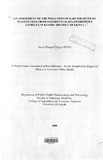| dc.description.abstract | Wastewater is an important source of environmental pollution. Both ground and surface
water is polluted by wastewater from abattoirs, domestic, agricultural and industrial effluent.
Wastewater from slaughterhouses contains both organic waste and micro-organisms.
Organic waste results in reduction in oxygen demand of receiving water thus affecting the
aquatic eco-system. Presence of micro-organisms may pose a public health risk to users of
the receiving water body.
The current study sought to assess the quality of effluent from the Dagoretti slaughterhouses
and its level of pollution in the receiving stream, the Kabuthi River.
Water samples were taken from taps in the slaughterhouses, effluent near the
slaughterhouses, at the point of discharge into the river, 200 metres upstream from the point
of discharge and 200 metres downstream from the point of discharge. Samples were taken at
weekly intervals for a period of nine weeks. There was no weather change during the
sampling period. The samples were analysed for total coliform, faecal coliform, faecal
streptococci, presence or absence of faecal Escherichia coli, presence or absence of
Salmonella, and for antibiotic resistance patterns of the isolated E. coli.
The water samples taken inside the slaughterhouse had insignificant counts of bacteria.
Samples collected at the point of discharge and downstream from the point of discharge had
very high counts of all micro-organisms considered. The total bacterial count was an
average of 1.5x 105 for samples taken 200 metres upstream from the point of discharge, 6.7x
108 200 metres downstream from the point of discharge, and 4.Ox1OSat the point of
discharge into the river.
There was a significant difference (p>0.05) between bacterial count of samples collected
upstream from the point of discharge and those at the point of discharge and downstream
from the point of discharge but there was no significant difference in counts from other
sample collection sites. Faecal streptococci counts were 3.3x 103 for samples taken upstream
from the point of discharge, 1.3x107 downstream to the point of discharge, 2Ax107 at the
point of discharge into the stream during peak operation; 1.1x 107 where effluent from
Nyongara, Thiani and Mumu slaughterhouses meet and lAx 105 for the point of discharge
into the stream before start of operations in the slaughterhouses.
Fifteen (15) samples (28.8%) were positive for faecal E. coli. Of the E. coli isolates,
13(65%) were resistant to one or two of the 12 antimicrobials tested while 4(25%) were
resistant to five or more antimicrobials. The isolates were resistant to ampicilin (25%),
sulphamethoxazole (25%), streptomycin (20%), tetracycline (20%), chloramphenicol (10%),
amoxyllinlclavulanic acid (10%) and nalidixic acid (5%).
There was no significant difference (p>0.05) in 5-day Biochemical Oxygen Demand (BODs)
between samples taken from the different sites except for samples collected upstream from
the point of discharge where the BODs level was below detectable level as compared to
BODs at the point of discharge (2944 mgll).
Salmonella was isolated from the site downstream to the point of discharge and one isolate
was identified as Salmonella typhimurium. | en |

